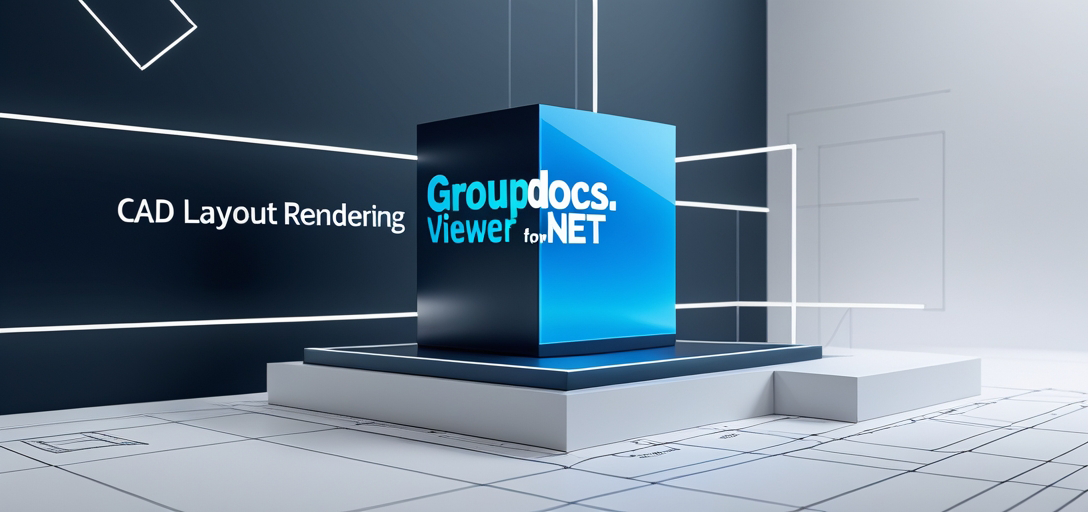Efficient CAD Layout Rendering with GroupDocs.Viewer for .NET
Introduction
Struggling with rendering specific layouts from a CAD drawing? Whether you’re preparing project presentations or conducting detailed design reviews, accessing the right layout is crucial. This step-by-step guide will show you how to use GroupDocs.Viewer for .NET to efficiently render specific CAD layouts, streamlining your document management workflows and boosting productivity.

What You’ll Learn:
- Setting up GroupDocs.Viewer for .NET in your project
- Rendering specific CAD layouts using C#
- Managing output directory paths effectively
- Practical applications of this functionality
Let’s start with the prerequisites!
Prerequisites
Before you begin, make sure these requirements are met:
Required Libraries and Versions
- GroupDocs.Viewer for .NET: Version 25.3.0 or later.
- Development Environment: Compatible IDE like Visual Studio.
Installation Methods
You can install GroupDocs.Viewer using NuGet Package Manager Console or .NET CLI:
NuGet Package Manager Console
Install-Package GroupDocs.Viewer -Version 25.3.0
.NET CLI
dotnet add package GroupDocs.Viewer --version 25.3.0
License Acquisition
GroupDocs offers a free trial, temporary licenses for extended evaluation, and purchasing options for long-term use. Visit their purchase page to get started.
Environment Setup Requirements
Ensure your development environment is set up with .NET Framework or .NET Core/5+/6+ installed.
Knowledge Prerequisites
Basic knowledge of C# programming and familiarity with CAD file structures will be beneficial.
Setting Up GroupDocs.Viewer for .NET
To begin rendering specific layouts from a CAD drawing using GroupDocs.Viewer, follow these steps:
Installation: Use the installation commands provided above to add the library to your project.
License Setup:
- Obtain a temporary or full license from GroupDocs.
- Apply the license in your application before using any features.
Basic Initialization and Setup: Here’s how you can initialize GroupDocs.Viewer with C# code:
using System;
using GroupDocs.Viewer;
string licensePath = "path/to/license.lic";
License license = new License();
license.SetLicense(licensePath);
// Initialize viewer with a sample CAD file
using (Viewer viewer = new Viewer("sample.dwg"))
{
// Rendering logic will go here
}
Implementing CAD Layout Rendering
Rendering Specific Layouts of CAD Drawings
This feature allows precise control over which parts of your CAD drawings are visible, aiding in focused analyses or presentations.
Step-by-Step Implementation
1. Initialize the Viewer: Begin by setting up your viewer with the CAD file:
using System;
using System.IO;
using GroupDocs.Viewer;
string outputDirectory = "YOUR_OUTPUT_DIRECTORY/";
string pageFilePathFormat = Path.Combine(outputDirectory, "page_{0}.html");
// Initialize the viewer with a sample CAD drawing.
using (Viewer viewer = new Viewer("@YOUR_DOCUMENT_DIRECTORY/SAMPLE_DWG_WITH_LAYOUTS_AND_LAYERS"))
{
// Proceed to set up HTML view options
}
2. Set Up HTML View Options: Configure your output settings for rendering:
using GroupDocs.Viewer.Options;
HtmlViewOptions options = HtmlViewOptions.ForEmbeddedResources(pageFilePathFormat);
// Specify the layout name to render, e.g., "Model".
options.CadOptions.LayoutName = "Model";
3. Render the Layout: Execute the view command to render your specified layout:
viewer.View(options);
Key Configuration Options
- Layout Name: Determines which CAD layout is rendered.
- Embedded Resources: Ensures all necessary resources are included in the output.
Managing Output Directory Paths
Efficient path management ensures your rendering outputs are organized and easy to locate.
1. Create a Path Manager Utility: Use this utility class for consistent path management:
using System;
using System.IO;
namespace Utils
{
public static class PathManager
{
// Method to get the output directory path.
public static string GetOutputDirectoryPath()
{
return Path.Combine(Directory.GetCurrentDirectory(), "YOUR_OUTPUT_DIRECTORY");
}
}
}
2. Utilize in Rendering Code: Incorporate this utility when setting up your output paths:
string outputDirectory = Utils.PathManager.GetOutputDirectoryPath();
string pageFilePathFormat = Path.Combine(outputDirectory, "page_{0}.html");
Troubleshooting Tips
- Ensure the specified CAD layout exists within the file.
- Verify that all necessary permissions are set for reading and writing files.
Practical Applications
Here are some real-world use cases:
- Architectural Presentations: Render specific floor plans or sections of a building model to present to clients.
- Engineering Reviews: Focus on particular assembly layouts during design reviews with stakeholders.
- Educational Content Creation: Generate layout-specific visuals for tutorials and educational materials.
GroupDocs.Viewer can also integrate seamlessly with other .NET systems, enhancing document management capabilities across your applications.
Performance Considerations
Optimizing performance is key when dealing with large CAD files:
- Memory Management: Dispose of the viewer object promptly after use.
- Resource Utilization: Optimize file sizes and reduce unnecessary rendering by targeting specific layouts only.
Adhering to these best practices ensures efficient resource usage and smooth operation.
Conclusion
In this tutorial, you’ve learned how to render specific CAD layouts using GroupDocs.Viewer for .NET. By setting up the viewer correctly, configuring output paths, and applying performance optimizations, you can significantly enhance your document rendering workflows.
Next Steps:
- Experiment with different layout configurations.
- Explore other features of GroupDocs.Viewer to expand its utility in your projects.
Ready to dive deeper? Implement these solutions in your environment today!
FAQ Section
- What is GroupDocs.Viewer for .NET?
- A library that allows viewing and rendering documents within .NET applications, supporting various formats including CAD files.
- How do I install GroupDocs.Viewer for .NET?
- Use NuGet or .NET CLI with the provided commands to add it to your project.
- Can I use GroupDocs.Viewer without a license?
- Yes, but you’ll have limitations. Consider obtaining a temporary license for full access during development.
- What file formats does GroupDocs.Viewer support?
- It supports over 90 document formats, including CAD drawings like DWG and DXF.
- How do I render specific layouts in a CAD file?
- Use the
CadOptions.LayoutNameproperty to specify which layout you want to render.
- Use the